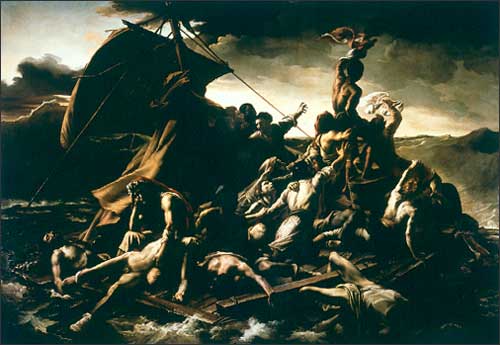The Raft of the Medusa

Théodore Géricault, c. 1818-19, oil on canvas,
approximately 16' x 24'(4.9 x 7.16 m), The Louvre in Paris, France.
Welcome to a free and open educational resource
for art history students and self-learners around the world.
Théodore Géricault (1791-1824)
- French romantic painter active in the early 19th century who died young - the result of a riding accident.
- Influenced by Michelangelo, Gros, Caravaggio, Rubens, Rembrandt.
- Romanticism was a school of thought that focused on emotional, mysterious, or imaginative subjects, remote and exotic in time and place.
- Some romantic artists liked to shock the viewer with grotesque subjects like the half-eaten corpse in the foreground of Gericault's Raft.
- Authenticity and realistic detail was very important to him.
- He interviewed actual survivors of the shipwreck and studied corpses in the morgue.
- A liberal, he opposed the new monarchy which was re-established after Napoleon.
It is thought that Théodore Géricault's masterpiece fueled French Romanticism, and contributed to a re-evaluation of the validity of the new French monarchy. For more information on the artist, his work, and the history of the event please view the recommended links below.
Recommended External Links
The Raft of the Medusa
Consult for further information on the painting and artist.
The History House
Consult the History House for further information on the history of the tragedy.
The Louvre
Official Museum Website
The Tate Museum
Also, The Tate Museum in London is currently displaying a full-scale copy in an exhibit on the French Romantics.
Aboard a Slave Ship, 1829
A minister recounts his experience of boarding a slave ship stopped off the coast of Africa. EyeWitness to History.com - History through the eyes of those who lived it, presented by Ibis Communications, Inc. a digital publisher of educational programming.
Sources:
Janson's History of Art, Prentice-Hall.
Gardner's Art History,

|